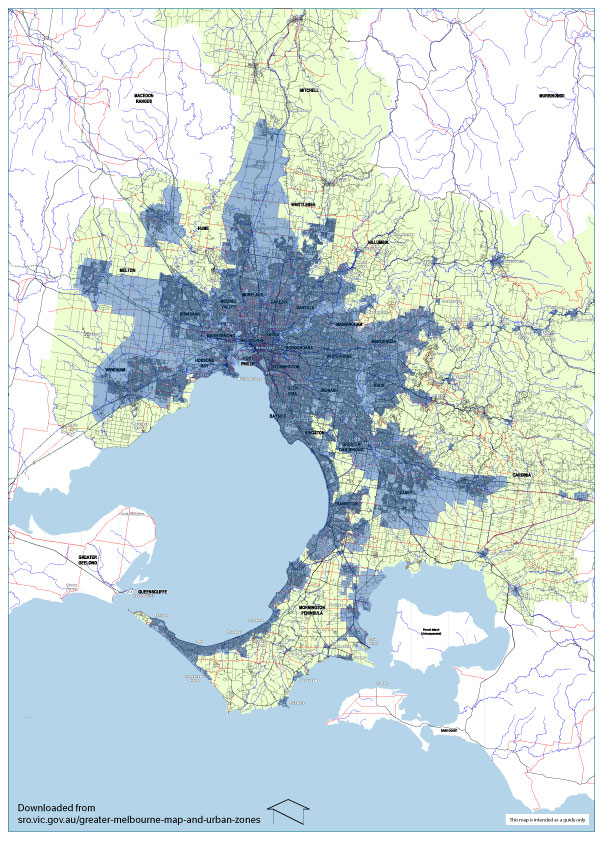Greater Melbourne and urban zones
Check map areas, boundaries and urban zone descriptions.
Key information
An exemption from land tax may be available if your land, or part of your land, is used for, or being prepared for, primary production.
To be eligible for this exemption, certain conditions must be satisfied. These vary depending on whether the land is:
- wholly outside of greater Melbourne, if it is used primarily for primary production
- wholly or partly within greater Melbourne but not within an urban zone, if it is used primarily for primary production
- wholly or partly within greater Melbourne and wholly or partly within an urban zone, if it is used solely or primarily for the business of primary production.
Greater Melbourne is the area within the Urban Growth Boundary and is marked on the current map of greater Melbourne. Prior to 18 June 2014, greater Melbourne had a different meaning.
An urban zone is a zone or part of a planning scheme that has been declared an urban zone, under a planning scheme in force under the Planning and Environment Act 1987, by the Governor in Council for land tax purposes. Urban zones can and have changed over time.
Current greater Melbourne
For land tax primary production exemption purposes, greater Melbourne is the blue shaded areas in the map below. This boundary took effect from 18 June 2014 and applies from the 2015 land tax year.
View a larger copy of the current greater Melbourne map

Map legend
- Blue: Greater Melbourne, which is the area within the Urban Growth Boundary. This comprises some complete council areas and some partial council areas.
- Green: Councils that have land both inside and outside the Urban Growth Boundary. The green denotes the parts of these councils falling outside the Urban Growth Boundary and therefore outside greater Melbourne.
- White: Council areas wholly outside greater Melbourne.
The blue shaded area is the combination of complete council areas and some partial council areas:
Complete council areas
- Banyule City Council
- Bayside City Council
- Boroondara City Council
- Darebin City Council
- Glen Eira City Council
- Maribyrnong City Council
- Monash City Council
- Melbourne City Council
- Moonee Valley City Council
- Merri-bek (formerly Moreland) City Council
- Port Phillip City Council
- Stonnington City Council
- Whitehorse City Council
- Yarra City Council
Partial council areas
Areas within the Urban Growth Boundary specified in the planning scheme in force in each of the following councils:
- Brimbank City Council
- Cardinia City Council
- Casey City Council
- Frankston City Council
- Greater Dandenong City Council
- Hobsons Bay City Council
- Hume City Council
- Kingston City Council
- Knox City Council
- Manningham City Council
- Maroondah City Council
- Melton City Council
- Mitchell Shire Council
- Mornington Peninsula Shire Council
- Nillumbik Shire Council
- Whittlesea City Council
- Wyndham City Council
- Yarra Ranges Shire Council
Urban zones
An urban zone is a zone or part of a planning scheme that has been declared an urban zone, under a planning scheme in force under the Planning and Environment Act 1987, by the Governor in Council. These zones change over time and new zones are declared as required for relevant tax years.
The current urban zones declaration is detailed below.
| Planning schemes | Zone codes | Description |
|---|---|---|
|
||
| ACZ | Activity centre zone | |
| B1Z | Commercial 1 zone | |
| B2Z | Commercial 1 zone | |
| B3Z | Commercial 2 zone | |
| B4Z | Commercial 2 zone | |
| B5Z | Commercial 1 zone | |
| C1Z | Commercial 1 zone | |
| C2Z | Commercial 2 zone | |
| C3Z | Commercial 3 zone | |
| CCZ | Capital city zone | |
| CDZ | Comprehensive development zone | |
| DZ | Docklands zone | |
| GRZ | General residential zone | |
| IN1Z | Industrial 1 zone | |
| IN2Z | Industrial 2 zone | |
| IN3Z | Industrial 3 zone | |
| LDRZ | Low-density residential zone | |
| MUZ | Mixed-use zone | |
| NRZ | Neighbourhood residential zone | |
| PDZ | Priority development zone | |
| PPRZ | Public park and recreation zone | |
| PZ | Port zone | |
| R1Z | General residential zone | |
| R2Z | General residential zone | |
| R3Z | General residential zone | |
| RGZ | Residential growth zone | |
| SUZ | Special use zone other than schedule 1 to special use zone (port-related use) under the Mornington Peninsula Planning Scheme | |
| TZ | Township zone | |
| UGZ | Part B of urban growth zone |
View the gazetted order declared by the Governor in Council on 28 December 2018
